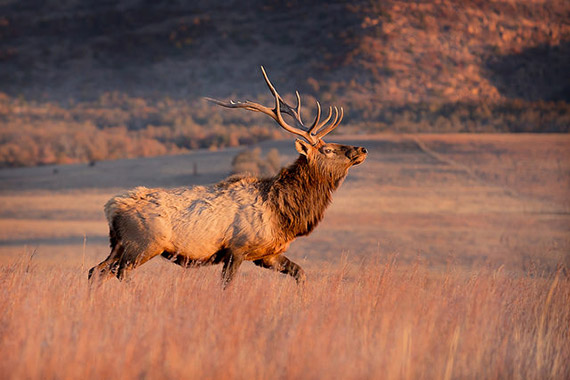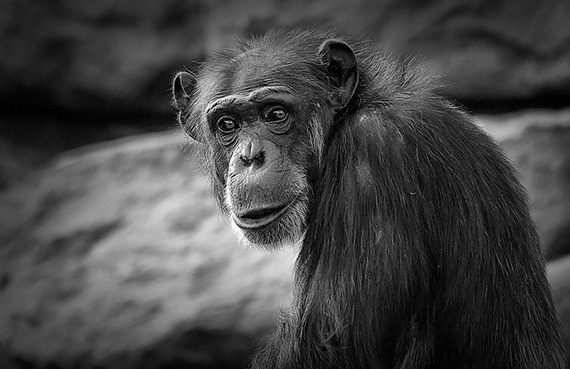Wildlife photography is a pursuit that can be challenging, frustrating, but ultimately rewarding to any photographer. The arrival of digital cameras has inspired a whole new generation of photographers to take an interest in wildlife photography.

photo by Larry Smith
Most photography courses, workshops and books concentrate on the technical aspects of camera craft: but really good photography relies more on composition, lighting, and sensitivity to your subject. This means you can improve your photography by thinking creatively, not technically.
Here are five of my top tips for taking better wildlife photographs:
1. Get to the subject’s eye level.
Wildlife photos are most effective if they create an intimate connection between the subject and the viewer. The best way to do this is to take your photo at the subject’s eye level. This way, your wildlife photo can create the illusion of sharing a moment inside the world of the subject, rather than from the outside looking in.
If, for example, your subject is low to the ground (like a lizard, frog, or even a pet), crouch or lie flat, getting as low as possible so you can take your photo at the subject’s eye level.

photo by Gemma Stiles
2. It’s all in the eyes.
The personal connection mentioned in tip #1 is really about eye contact, so it is important to get the eyes right. If the eyes in your wildlife photo are sharp and clear, the photo will probably work. If they are out of focus, lost in shadow, or if the subject blinks or turns its eyes away, the connection will be lost, and the photo will almost certainly fail.
You don’t even need your whole subject to be in focus. Your animal could be mostly hidden by leaves, in shadow and out of focus. The picture could still work…as long as the eyes are open and captured sharply in the picture.
3. If the background doesn’t help, get rid of it.
Many wildlife photos are spoiled because the background is cluttered, distracting, ugly, or just plain inappropriate. For example, seagulls on a beach can be quite beautiful, but seagulls at the local rubbish tip is a different matter. Also, wildlife photos look far less natural if you can tell they were taken in a zoo. Apply this principle: “Anything that does not make my photo better makes it worse.”

photo by Kristina Servant
This does not mean you can’t take a good wildlife photo at the zoo, at the tip, or anywhere else for that matter. You just need to manage it. If your background is spoiling your shot, zoom right in on the subject to eliminate as much of the background as possible. By zooming in, you will also reduce the depth of field to a minimum, so any background that does appear in your photo will be out of focus and less distracting.
4. If your background is working for you, use it well.
A wildlife photograph that captures the subject in a beautiful natural setting can be even more effective than a simple close-up. My photos of a kangaroo on the beach, for example, show the subject in an unexpected context, making a more interesting image than a close-up portrait style photo.

photo by James Brooks
If you take your wildlife subject as part of a wider landscape, you need to consider all the techniques of composition that apply to landscape photography. Remember the rule of thirds (which may or may not help) and be careful to position your animal so that the subject and the background work together to make a more effective composition. In particular, try to position your wildlife subject so that it looks toward the center of the picture, not towards the edge of the frame.
5. Capture your subject in the best possible light.
Even the most perfectly composed wildlife photo can fail because of bad lighting. Losing your subject in the shadows, glare reflecting off shiny feathers, and shadows across the face of the subject are all simple mistakes that can ruin a photo.

photo by CheepShot
There is no single rule for lighting in a wildlife photograph, but here are some suggestions. I often find the best results when the sky is lightly overcast with thin cloud. This produces light that is bright, but soft and even compared to full sunlight. Your subject will be well illuminated, but you avoid harsh contrast and heavy shadows that rob the image of important detail.
If the weather is sunny, try to take your photos early and late in the day when the sun is low. At these times the light is soft and warmly colored. It is also easier to catch the full face of your subject in sunlight, rather than half-obscured by shadow.
So there you have my five tips for wildlife photography. I could cheat and add tip #6: take lots of photos. Animals twitch, flap their wings, blink, and generally find a way to frustrate even the most patient photographer. Don’t forget, with digital photography it costs you nothing to keep snapping. So practice, persevere, and try out these tips…you could be taking better photos in no time.
About the Author:
Andrew Goodall writes for https://naturesimage.com.au/ and is a nature photographer based in Australia. He manages a gallery in Montville full of landscape photography from throughout Australia.
Like This Article?
Don't Miss The Next One!
Join over 100,000 photographers of all experience levels who receive our free photography tips and articles to stay current:






I love the way how you explain this article in simple way and thank you for guiding us and telling us a tip for Better Wildlife Photos.This article really helpful for us.Thank you writing such helpful article.
It’s interesting that wildlife photography has so much art to it. It makes sense that a regular Joe would have a hard time to it! I never would have even thought to blur out the background if it doesn’t help the main focus.
Really simple but useful info! I am taking a bunch of kids out to do some fun and simple wildlife photography soon and your tips have really helped me plan the event!
Great advice
All you have to doo is to buy lens of 1500$ or canon sx30-sx50.
$1500 lens or cannon sx50? a camera with a tiny sensor that costs 1/3 of the lens you mention?
You’re not even comparing apples to apples. I don’t think you’re very well informed.
All great tips, Andrew!! thank you!!!
Thanks for sharing, i really appreciate. Thanks again. Best of luck